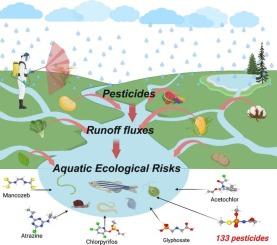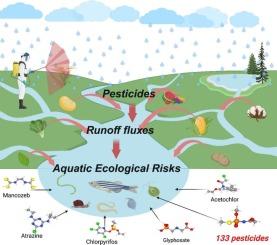Unfolding pesticide transport from land to rivers and the resulting aquatic risks in China
IF 9.7
1区 环境科学与生态学
Q1 ENVIRONMENTAL SCIENCES
引用次数: 0
Abstract
Pesticides have been widely applied in China, potentially leading to negative effects on the aquatic ecosystem. However, a national risk map of pesticide active ingredients (AIs) to aquatic species is still lacking. In this study, we used a nationwide spatially explicit pesticide input dataset to estimate the riverine concentrations of 133 AIs in China and further assessed the risks to aquatic species. Our analysis shows that pesticides were intensively applied in the North China Plain and the middle and lower reaches of the Yangtze River basin, with rice and maize received the highest shares of input at 42% and 21%, respectively. Under the current pesticide input patterns, in total 631 tons of pesticides, which is approximately 0.04% of applied pesticides, were transported into rivers through runoff. Atrazine showed the highest predicted concentrations in rivers, followed by propisochlor and nicosulfuron. Aquatic risks were found in 57% of river basins, with 5% and 13% of rivers exhibiting extremely high and high risks. Extremely high and high risk were found mainly in upper reaches of the Yangtze River, middle reaches of the Yellow River, and the Pearl River. Notably, endosulfan was the major contributor to aquatic risk, with an input only accounting for 0.4% of the national input mass. Our analysis facilitates more precise pesticide supervision and the designation of risk mitigation strategies.


在中国展开农药从陆地到河流的运输和由此产生的水生风险
农药在中国被广泛使用,可能对水生生态系统造成负面影响。然而,我国目前还缺乏农药有效成分对水生物种的风险分布图。在本研究中,我们利用全国范围内的空间显式农药输入数据,估算了中国133种农药的河流浓度,并进一步评估了其对水生物种的风险。分析结果表明,华北平原和长江中下游地区农药投入较为密集,其中水稻和玉米的农药投入比例最高,分别为42%和21%。在目前的农药投入模式下,通过径流进入河流的农药总量为631吨,约占施用量的0.04%。阿特拉津在河流中的预测浓度最高,其次是异丙氯和尼科隆。57%的河流流域存在水生风险,其中5%和13%的河流表现为极高和高风险。其中,长江上游、黄河中游和珠江流域主要为极高、高风险区。值得注意的是,硫丹是水生风险的主要贡献者,其投入仅占全国投入质量的0.4%。我们的分析有助于更精确的农药监管和风险缓解策略的指定。
本文章由计算机程序翻译,如有差异,请以英文原文为准。
求助全文
约1分钟内获得全文
求助全文
来源期刊

Environment International
环境科学-环境科学
CiteScore
21.90
自引率
3.40%
发文量
734
审稿时长
2.8 months
期刊介绍:
Environmental Health publishes manuscripts focusing on critical aspects of environmental and occupational medicine, including studies in toxicology and epidemiology, to illuminate the human health implications of exposure to environmental hazards. The journal adopts an open-access model and practices open peer review.
It caters to scientists and practitioners across all environmental science domains, directly or indirectly impacting human health and well-being. With a commitment to enhancing the prevention of environmentally-related health risks, Environmental Health serves as a public health journal for the community and scientists engaged in matters of public health significance concerning the environment.
 求助内容:
求助内容: 应助结果提醒方式:
应助结果提醒方式:


